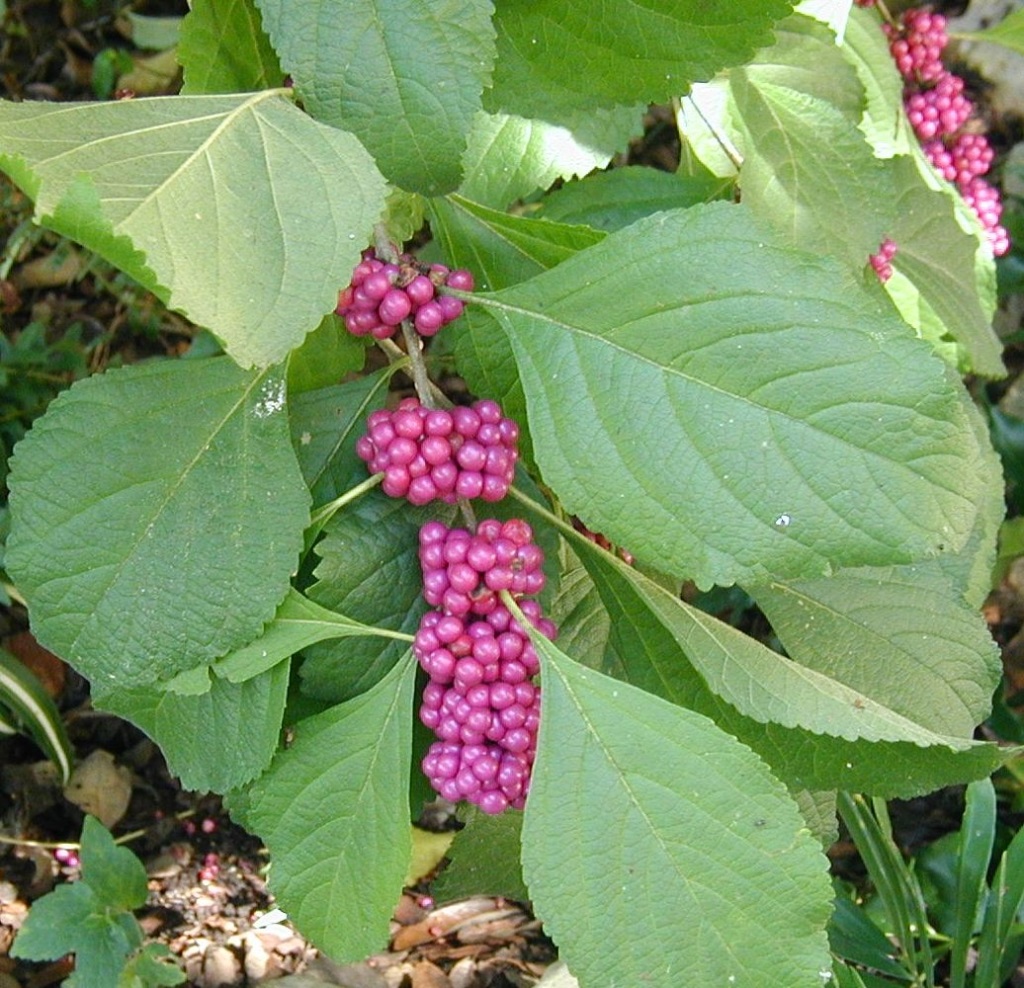Author: Bill Ward
Operation NICE! (Natives Instead of the Common Exotics!) recommendation for April is another top-favorite landscape plant — American beautyberry. This is a planning-ahead recommendation. American beautyberry won’t be at its showiest for months, but this is a good time to plant beautyberries for fall gratification. During early fall, the limbs become shish kebabs of bright purple berries.
American beautyberry (Callicarpa americana) is an easy-to-grow shrub that does well in the shade of large trees. Beautyberry commonly reaches four to six feet high, sometimes higher, and spreads laterally for many feet. This large bush needs a little room to spread.

American beautyberry is multi-branched and has large light-green ovate leaves. Patches of tiny white, pink, or blue flowers develop along the limbs during late spring. The flowers soon give way to clusters of green berries that presently turn magenta-purple.
This shrub can provide a good screen from spring to early winter. During some falls the leaves are bright lemon-yellow, but the autumn color is not dependable. Winter limbs are bare, but clusters of purple berries may remain even after the leaves fall. How long the berries stay depends on the birds in the vicinity. Mockingbirds, cardinals, and summer tanagers find the berries on our large backyard beautyberry too good to resist.
I first took notice of American beautyberry over 50 years ago when we moved to East Texas as newlyweds. My geologic mapping took me into the piney woods, where I discovered a whole set of plants unknown to a boy from Central Texas. In those damp eastern woods, American beautyberry grows with ferns, wild azaleas, and flowering dogwood.
Long before there was a Native Plant Society of Texas, I discovered that some of those piney-woods plants can be good landscape plants. Our backyard in Tyler had many trees, shrubs, and flowers that were transplanted from the nearby woods. One of our favorites was the American beautyberry or, as they called it in East Texas, “French mulberry.” After we moved to New Orleans, we continued the practice of landscaping with native plants, including American beautyberry, which there was called “Spanish mulberry.”
When we came to the Boerne area many years ago, I was startled to see a healthy growth of American beautyberry on stream terraces at the Cibolo Nature Center. I had thought this was an eastern plant that needed acid soil. I was pleased to learn that the western limit of its range extends to Kendall and Bexar Counties, where it does just fine in the moist soils of canyons and bottomlands.
What pleased me even more was to find that American beautyberry is readily available at local nurseries, and we could continue to have it as a yard plant. Besides that, white American beautyberry (C. americana var. lactea) sometimes can be found at local nurseries. Its white berries are an interesting contrast to the usual purple clusters.
As I learned through the years, American beautyberry is easy to transplant and can be cultivated in a variety of soil types. It is fairly drought-tolerant if grown in the shade. Even in shady spots, however, the leaves may look droopy in midday summer heat. Beautyberries grown in the sun require more water. Severe heat and drought may cause this plant to temporarily defoliate.
In many places in the wild, American beautyberry seems to escape heavy browsing by deer. However, in our neighborhood, American beautyberry is snipped by deer, at least during dry periods. All of our beautyberries have to grow inside wire-fence exclosures. If we are to have interesting diversity among our landscape plants in this area of deer over-population, then exclosures are necessary. Besides, I hardly notice the wire fences anymore, and I’m certainly glad to be able to enjoy the various plants.
The Boerne Chapter of the Native Plant Society of Texas provides free planting and care instructions for American beautyberry at the nurseries participating in Operation NICE! (Hill Country African Violets & Nursery and Maldonado Landscape & Nursery in Boerne and Medina Garden Nursery in Medina). The instruction sheets also are available at Cibolo Nature Center.


